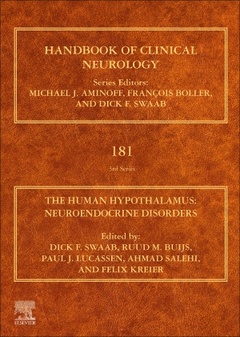The Human Hypothalamus Neuroendocrine Disorders Handbook of Clinical Neurology Series
Coordonnateurs : Swaab Dick F., Buijs Ruud M., Lucassen Paul J., Salehi Ahmad, Kreier Felix

1. Introduction: The human hypothalamus and neuroendocrine disorders SECTION 15 Structural disorders of the hypothalamo-pituitary region 2. Pituitary stalk interruption syndrome 3. Empty sella syndrome: Multiple endocrine disorders 4. Pituitary dysfunction after aneurysmal subarachnoidal hemorrhage 5. Septo-optic dysplasia SECTION 16 Tumors of the hypothalamus 6. Hypothalamic hormone-producing tumors 7. Craniopharyngiomas primarily affecting the hypothalamus SECTION 17 Neuroimmunological disorders 8. The stress-axis in multiple sclerosis: Clinical, cellular, and molecular aspects 9. Neuroendocrine manifestations of Langerhans cell histiocytosis 10. Neuroendocrine manifestations of Erdheim–Chester disease 11. Hypothalamitis and pituitary atrophy 12. Narcolepsy Type I as an autoimmune disorder 13. Neuromyelitis optica, aquaporin-4 antibodies, and neuroendocrine disorders 14. Antibodies against the pituitary and hypothalamus in boxers 15. Autoimmune diabetes insipidus SECTION 18 Drinking disorders 16. Neuroimaging of central diabetes insipidus 17. Differential diagnosis of familial diabetes insipidus 18. The vasopressin–aquaporin-2 pathway syndromes 19. Adipsic diabetes insipidus 20. Animal models for diabetes insipidus 21. Nocturnal enuresis in children: The role of arginine–vasopressin SECTION 19 Eating disorders 22. Monogenic human obesity syndromes 23. Hypothalamic microinflammation 24. Glucose and fat sensing in the human hypothalamus 25. Hypothalamus and neuroendocrine diseases: The use of human-induced pluripotent stem cells for disease modeling 26. Prader–Willi syndrome: Hormone therapies 27. Transcriptomics of the Prader–Willi syndrome hypothalamus 28. Disorders of hypothalamic function: Insights from Prader–Willi syndrome and the effects of craniopharyngioma 29. Animal models for Prader–Willi syndrome 30. Is there a hypothalamic basis for anorexia nervosa? SECTION 20 Reproduction, olfaction and sexual behavior 31. Sexual differentiation of the human hypothalamus: Relationship to gender identity and sexual orientation 32. Klinefelter syndrome or testicular dysgenesis: Genetics, endocrinology, and neuropsychology 33. Neurobiology of puberty and its disorders
Dick Swaab (1944) earned his medical and doctoral degrees at the University of Amsterdam, where he became involved in brain research during his third year of medical school. He was Director of the Netherlands Institute for Brain Research from 1978 to 2005. Since 1979 he is Professor of Neurobiology at the Medical Faculty, University of Amsterdam.
In 1985, Dr. Swaab founded the Netherlands Brain Bank (NBB) to serve as a source of clinically and neuropathologically well-documented research tissue. Since its founding, the Brain Bank has provided samples from more than 4,000 autopsies to 500 research groups in 25 countries. He was director of the NBB until 2005.
He is Leader Research team Neuropsychiatric Disorders, Neth. Inst for Neuroscience, an institute of the Royal Netherlands Academy of Arts and Sciences (KNAW). Swaab is also appointed for 2011-2017 Chao Kuang Piu Chair of Zhejiang University, Hangzhou, P.R. China.
His major research interests focus on, sexual differentiation of the human brain in relation to gender identity and sexual orientation, aging of the brain, Alzheimer’s disease, the neurobiological basis of depression, suicide and eating disorders. He has published over 540 papers in SCI journals, authored more than 200 chapters in books, and edited more than 60 books. Swaab mentored 84 PhD students from which 16 are now full professor. He is “Companion in the Order of the Dutch Lion, bestowed by her Royal Majesty Queen Beatrix of the Netherlands. In 2008 Swaab obtained the Academy medal for his role in national and international neuroscience.
Dick Swaab is author of the 2 volume monograph The Human Hypothalamus that appeared in the Handbook of Clinical Neurology series, Elsevier, Amsterdam (1000 pp) and the Dutch best seller We are our Brains (450.000 copies sold), that is translated in 14 languages. A children's version of the book (You are your brains) has also appeared in Dutch in 2013 and Russian (2014). Swaab's H-facto
- Discusses the importance of the hypothalamus in human growth and development
- Reviews hypothalamic related tumors, as well as pituitary, autoimmune, vasopressin and hormone regulation disorders
- Includes metabolic and eating disorders
- Identifies mechanisms of disease action and etiology
- Provides best practice information for assessment and treatment
Date de parution : 09-2021
Ouvrage de 566 p.
19.2x26.1 cm
Thèmes de The Human Hypothalamus :
Mots-clés :
neuroendocrine disorders; hypothalamus; hypothalamic; pituitary; hormone regulation; endocrine



